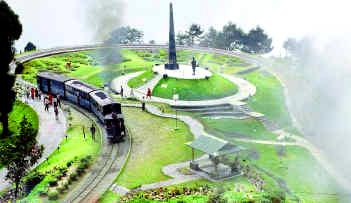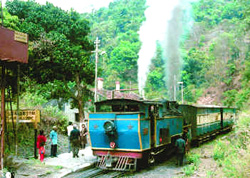Once
the Darjeeeling toy train won its spurs, it was only a matter of
time before the Nilgiri Mountain Railway would have to be internationally
acknowledged in the UNESCO World Heritage List. India becomes the
only country to flaunt two feathers in its transport cap. |
 |
India
has four mountain railway systems, namely the Darjeeling Himalayan,
the Nilgiri Mountain,
the Kalka-Shimla and
Kangra Valley (bracketed together because
they share the same narrow — 2ft 6ins — gauge) and the Neral-Matheran.
The first and last run on two-feet gauge while the Nilgiri uses the metre gauge
with a third notched line in between to make it India's only rack railway.(The
other three stick to adhesion.) The remarkable array of gauges and modes of
ascent are testimony not
only to
the originality and ingenuity of railway
engineers who came up with different solutions
to specific regional problems, but |
| also to the brilliant gifts of improvisation displayed by the running
staff who have kept most of these mountain
lines operational after more than a century. |
| The four hill railways |
Each of the four hill railways possesses its own unique character: the climax of the long Darjeeling line is a darshan of Kanchenjunga, while the last section of the Kangra Valley line runs parallel to the snow peaks of the Dhaula Dhar. The Ooty and Shimla lines vie for the prize of prettiest stations while the Matheran line (by virtue of its antiquity) is allowed entry to a hill station that bans the motor car. These railways were easily distinguishable in earlier days by the differing profiles of the steam locomotives employed on them. Darjeeling went in for tiny British saddle tank engines while Matheran and Shimla preferred German side-tankers. The Matheran engines, because of the tight curves, were articulated and sported a bearing the size of a football! Since the Nilgiri rack railway was a Swiss invention, the locos that still run it — fitted with extra pistons to work the rack mechanism — were imported from Switzerland. The contrast in styles is also evident in the wayside railway works: while the Kalka-Shimla line has over 100 tunnels, the New Jalpaiguri-Darjeeling line has none worth the name. In an age wedded to speed and efficiency it is remarkable how public affections continue to cherish the slow and unsteady pace of the hill lines. This pride in past workmanship has been rewarded in recent years with the Darjeeling Himalayan Railway being inducted into the UNESCO list of World Heritage Site.
In fact they pack four times the tractive effort of the Darjeeling engines!) The chief feature of the Ooty train is that the engine is always at "the Mettupalaiyam end", that is to say it is pushing the train up from the back. The rack mechanism is lowered by the engine crew to engage with the toothed middle rail and has to be smartly disengaged before entering Coonoor. Since the engine driver is running up this steep and thickly wooded valley blind to the line ahead, each of the four carriages sports a small verandah on which is stationed an alert brakeman armed with flags. As the train enters a curve the leading brakeman semaphores back the all clear to the following coachman who in turn relays the signal till it reaches the engine driver. This primitive, but precise, drill reveals the Indian Railways at its disciplined best. The Southern Railway has always prided itself in its turnout and kept the rack section running despite the revenue deficit. Avant-garde in its thinking, this Tamil Nadu line boasts of at least one lady station "master" in a Madonna-blue sari who "mans" the points, closes the level crossing gates and flags off the trains. As good fortune would have it the General Manager in recent days was R.R. Bhandari, an authority on steam heritage. He experimented with converting the Swiss locos from coal burning to oil burning. He is also author of the best short history of India's exotic hill railways, available from the National Rail Museum in New Delhi. India's mountain railways are remarkable engineering achievements. Two of them are now rated amongst the world's most romantic transport experiences. But can modern railwaymen emulate the passion for steam preservation that fired an earlier generation? Diesel traction is too prosaic to generate the huge tourist revenue that the Darjeeling and Ooty lines promise. Only the continued poetic motion of steam can hope to rope in the crowds. |
